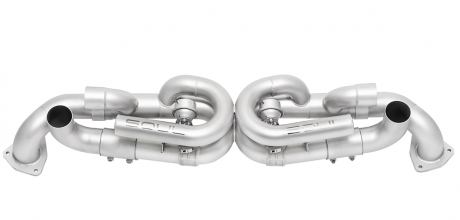Technology explained PSE

Switchable technology enables drivers to alter the noise from the modern 911’s exhaust. Here’s how…
One of the most characterful elements of the 911 is the exhaust note. Whatever model you have, the soundtrack is a constant reminder of partly why we enjoy the cars so much. That sound comes via the exhaust system. While an exhaust’s job is mainly to vent combustion gases to the atmosphere, it has a secondary task: to control the sound, primarily to comply with noise regulations. It does this via a combination of pipework and silencers, and by modifying the variations of these, the sound of the car can range from restrained to raucous. Until the 996, owners had to choose which note they preferred, and commit to it. Since 2002 on the 996, we’ve had the option of a switchable Porsche Sports Exhaust (PSE).
PSE uses a ‘regular’ exhaust system, but with two vacuum-controlled valves on the silencers. These enable the driver to select a quiet or sporting exhaust note. By pressing a button on the dash, the driver controls solenoid valves that re-route the air through the exhaust in one of two ways. The first route is the typical one, where combustion gases enter the silencer(s) via a regular-width pipe, are diffused through silencing wadding and venting holes that disrupt the gas flow and sound waves – therefore reducing their volume and harshness – before venting them out through the tailpipe. All this relies on air pressure, originating when the pistons push waste gases out on each combustion stroke, creating resistance through the exhaust as the gases flow out. This air resistance helps diffuse the gases through the silencing media, reducing resonance.
The second mode opens the bypass valves. This causes the gases to enter the silencer via larger-bore pipework, then flow through the silencer chambers with fewer restrictions or, on the 991 bypass, the secondary silencers altogether. This enables exhaust gases to flow out with reduced resistance and with less of a drop in noise levels, giving a more muscular exhaust note.
On later cars, like the 991 GT3, the PSE system isn’t just on or off – it also takes into account engine speed. Yet regardless of PSE being switched on or off, above 3,800rpm the valves open, partly to aid exhaust gas flow. With the system active, the valves are open below that, increasing mid-range torque from the reduced back pressure, as well as increasing exhaust noise.
Note that the valve solenoids operate on a vacuum, so that’s partly why the exhaust is loud on startup. The engine needs to be running to build vacuum and that takes time, permitting closing of the valves to the ‘loud’ part of the system. The idea may be a simple one, but understanding it has enabled creative owners to employ the concept in other ways, as we’ll see next month.

